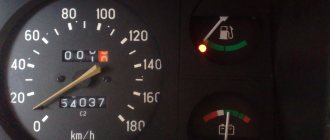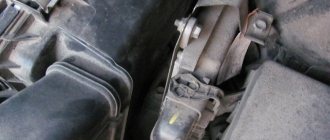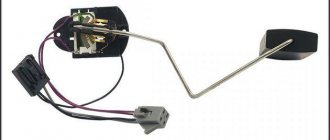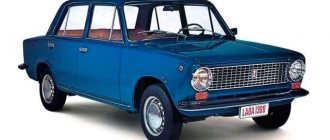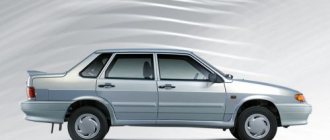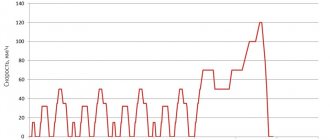In today's article we will talk about the cars of the Volzhsky Automobile Plant. Despite the emergence of new car models, experienced drivers still prefer to choose an “iron horse” based on its consumer ability: real and declared.
For example, the declared fuel consumption of the VAZ 21053 per 100 km is 9.1 liters. But in fact, fuel consumption on the Lada 21053 when traveling in the city is on average 8.1 liters, and outside the city - 10.2 liters.
Moreover, these are average figures that correspond to approximate mileage with engines of the same power. It is for their reliability and affordable price that Lada cars are loved.
| Engine | Consumption (highway) | Consumption (city) | Consumption (mixed cycle) |
| 1.5 l 5-mech | 5.2 l/100 km | 8.9 l/100 km | 7 l/100 km |
| 1.6 l 5-mech | 8.5 l/100 km | — | — |
| 1.3 l 5-mech | 9.5 l/100 km | 12.5 l/100 km | 11 l/100 km |
Leakage problem: what threatens it and how to determine it
Many novice drivers wonder: why is so much attention paid to fuel consumption? If you have a carburetor, then increased fuel consumption not only hurts your pocket, but also indicates malfunctions and (or) improper care of the car. That is, if the standard fuel consumption for a 2105 in the city is no more than 10.5 liters, but it takes you 15, it’s worth thinking about. Perhaps there is a leak somewhere? You can view the standards in the technical specifications for your car.
If your car was purchased not in the 80s of the twentieth century, but later, then you have a solex type carburetor, which has little in common with the “ozones” with which the “career” of the Volzhsky plant began. These two types of carburetors differ only in the control system, but in essence their operation is one and the same.
If the fuel consumption on a carburetor VAZ 2105 is much higher than the specified standards, check the damper and valves, clean the jets and the engine air filter, using special tools for this.
If these points do not help, you should contact a service station. Remember that VAZ 2105 (injector) gasoline consumption is 0.2-0.3 liters per 100 km more.
What can determine the amount of fuel spent?
- Real gasoline consumption of a VAZ 2105 in the highway cycle with an engine power of 64 hp. is 9.5 liters at a speed of 120 km/h and 6.8 liters if the speed is up to 90 km/h. When driving around the city - 10.2 liters. The difference is the four-speed gearbox.
- Average gasoline consumption for a VAZ 2105 with a five-speed gearbox and an engine of 71.1 hp. on average 0.2 liters lower.
Owner reviews
“I always thought that our cars should not be used at all. But after the crisis began, I had to sell my favorite foreign car and buy something cheap, that is, our car. I chose the five because in terms of price/quality ratio it was more or less. Naturally, it is equipped with only the most necessary functions for movement. The design is sparse, but the body is made as if from armor. It's impossible to break through. The engine is rather weak, but it consumes less fuel than my old car. The maximum I got was 12 liters, but that was in the winter, otherwise no more than 10,” writes Nikolai from Penza.
“As soon as I got my license, I started thinking about buying some kind of car that I wouldn’t mind killing. I immediately dismissed all options with foreign cars and focused on finding a good representative of our automobile industry. I chose the five because it is not expensive, and the equipment is not very different from other models. I drove it for about five years, during all that time I never had it repaired, except for small things. It is poorly equipped, but it is assembled with high quality. The engine is well suited for the city, but rather weak for the highway. It’s bad that the car has high consumption – about 12 liters,” says Grigory from Smolensk.
“I got the car from my father. I drove it for a couple of years and decided to sell it, since I spent a lot of money on it. And it’s not a matter of repairs, everything was fine here, but a matter of gasoline consumption. A small one and a half liter engine eats as if it were a six liter one. Moreover, its power is clearly less than stated in the passport, but it quickly consumed its 16 liters. I don’t want to deal with our cars anymore,” wrote Denis from Kostroma.
“I believe that only a very rich and brave person can own this car. It often breaks down, is very poorly equipped, looks terrible, I’m generally silent about the engine, it’s barely strong enough to just move around the city. But what bothers me the most is the huge fuel consumption. In the city it can reach 15 liters, and in the summer. In winter the situation is still good - about 17 liters. On top of all this, it’s impossible to start the car; you have to tinker with the engine for a very long time,” this is the review left by Kirill from Desnogorsk about this car.
“I read a lot of reviews about this car and almost everyone doesn’t like the fact that it consumes a lot of fuel. Why I don't have this problem, I don't know. My one and a half liter power unit spends no more than 10 liters, and it always works stably, never stalls and starts the first time in any weather. People also complain about poor equipment and poor appearance. Well, what did they want from a classic for a ridiculous price? The main thing is that it drives at least somehow, this is the main thing in our cars. For comfort, you can find a foreign car,” said Vladislav from Nizhny Novgorod.
“While I was driving a VAZ 2105, I realized that our cars are not so bad. Yes, their design leaves much to be desired, as does the interior design. But everything is done with high quality, with the expectation of long-term use without repair. In the almost 10 years that I have used the car, I have never been to a service center to repair the chassis, transmission or engine. Only consumables were changed, the main thing is proper and timely care and then you won’t kill the car at all. The only thing I didn’t like was fuel consumption, which reached 14 liters. I solved this problem with firmware,” writes Andrey from Ivanovo.
Fuel consumption Lada 2105 1979, sedan, 1st generation
| Engine capacity | Power | Transmission | Drive unit | Fuel | Consumption |
| 1.3 l | 69 hp | Manual transmission | rear wheel drive (FR) | Gasoline AI-92 | 8,0 |
| 1.3 l | 64 hp | Manual transmission | rear wheel drive (FR) | Gasoline AI-92 | 8,2 |
| 1.2 l | 59 hp | Manual transmission | rear wheel drive (FR) | Gasoline AI-92 | 8,2 |
| 1.6 l | 82 hp | Manual transmission | rear wheel drive (FR) | Gasoline AI-95 | 8,5 |
| 1.6 l | 80 hp | Manual transmission | rear wheel drive (FR) | Gasoline AI-95 | 8,5 |
| 1.5 l | 71 hp | Manual transmission | rear wheel drive (FR) | Gasoline AI-92 | 8,8 |
| 1.5 l | 50 hp | Manual transmission | rear wheel drive (FR) | Diesel fuel | 8,8 |
| 1.3 l | 140 hp | Manual transmission | rear wheel drive (FR) | Gasoline AI-92 | 9,5 |
Official data (l/km)
| Engine | Consumption (city) | Consumption (highway) | Flow (mixed) |
| 1.2 MT 64 hp (Mechanics) | 10.0 | 6.3 | 7.5 |
| 1.3 MT 63 hp (Mechanics) | 9.4 | 6.9 | 7.3 |
| 1.3 MT 64 hp (Mechanics) | 9.4 | 6.9 | 7.3 |
| 1.3 MT 140 hp (Mechanics) | 10.2 | 6.2 | 7.9 |
| 1.5 MT 71 hp (Mechanics) | 9.6 | 7.4 | 8.8 |
| 1.5 MT 75 hp (Mechanics) | 10.3 | 7.4 | 10.1 |
| 1.6 MT 73 hp (Mechanics) | 10.1 | 6.8 | 8.5 |
| 1.6 MT 74 hp (Mechanics) | 9.6 | 7.1 | 8.5 |
| 1.5 MT 50 hp diesel (mechanics) | 6.7 | 5.8 | 6.1 |
The legendary classic was equipped with four different gasoline engines, as well as one diesel engine. The first petrol unit is 1.2 liters. Its power was 64 horsepower, and a carburetor was responsible for supplying fuel. Fuel consumption per 100 km of this configuration was registered at 7.6 liters.
The next engine was 1.3 liters, the power of which was also 64 horsepower. The carburetor was also responsible for fuel here. There was also a special version with a rotary engine, the peak power of which was as much as 140 hp. Gasoline consumption here varied from 7.6 to 7.9 liters.
The first power plants, where an injector was installed, had a volume of 1.5 liters. The power of this version was 71 horsepower, and the consumption was 8.9 liters. The highest consumption was in the version with the 1.6 liter engine. With a power of only 74 hp, it consumed up to 9.1 liters of fuel. Both a carburetor and an injector could be installed here.
The diesel representative had a volume of 1.5 liters and developed only 50 horsepower. However, its consumption was at 6.1 liters. All power plants were controlled by five-speed manual transmissions.
VAZ 2101
Under this name, the first Zhiguli model appeared at the Volzhsky Automobile Plant. The VAZ 2101 became a pioneer in the family of the most popular domestic cars, enjoying success both among Soviet drivers and abroad. This car rolled off the factory assembly line in 1970, and production of the “penny” continued until 1988, after which it was replaced by new modifications on the same platform. VAZ 2101 was recognized as “The best domestic car of the 20th century.” Over the entire production period, only one of two engine options was installed on this model: either a 1.2-liter engine with a capacity of 64 hp, or a 1.3-liter power unit with 69 “horses”. Both engines were accompanied by a four-speed manual transmission.
| Engine | Consumption (city) | Consumption (highway) | Flow (mixed) | Type of fuel |
| 1.2 MT 64 hp | 9.4 | 6.8 | 8.0 | Petrol |
| 1.3 MT 69 hp | 9.4 | 6.8 | 8.0 |
Review of the Lada 2105 model
The VAZ-2105 car was produced at the Tolyatti Automobile Plant (as well as at the KraSZ factories in Ukraine and Lada Egypt in Egypt) for 31 years - from 1979 to 2010, i.e. it was in production longer than any other VAZ model. By the end of the 2000s, thanks to the minimum configuration, the “five” was cheaper than each of the Volzhsky Automobile Plant models produced at that time - 178 thousand rubles in 2009.
The VAZ-2105 car was produced at the Tolyatti Automobile Plant from 1979 to 2010
Having replaced the first-generation Zhiguli, the VAZ-2105 received a more contemporary appearance at that time with angular shapes and matte black decorative elements instead of the previously used chrome ones. The creators of the new model sought not only to simplify assembly, but also to achieve an acceptable cost for the car . For example, the abandonment of chrome-plated parts made it possible to get rid of the long and labor-intensive technological process of applying several layers of non-ferrous metals to steel. Among the innovations that were not present on previous VAZ models were:
- timing belt (instead of the previously used chain);
- polyurethane panels in the interior, made by solid stamping;
- block headlights equipped with hydraulic corrector;
- combination of clearance lights, turn signals, reversing lights, brake lights and fog lights under one rear lamp shade;
- heated rear window as standard.
In addition, the rotating wind triangles on the windows of the front doors of the new car were removed, and side nozzles began to be used to blow these windows. The driver could now adjust the position of the side mirrors from the passenger compartment; height-adjustable headrests were provided for front passengers.
A very good car for the money, I bought it as my first car and didn’t regret it later. I drove it for 1.5 years, invested a little after the previous owner and hit the road! During operation, no special problems arose, just little things related to maintenance, you just need to change everything on time and take care of the car, and not wait until it falls off on its own! Possibility of tuning, a large selection of spare parts, and all auto stores have almost all spare parts, not counting disassembly ones.
The rotating wind triangles on the windows of the front doors of the new car were removed, and side nozzles began to be used to blow these windows
More about tuning the VAZ 2105: https://bumper.guru/klassicheskie-modeli-vaz/tyuning/tyuning-vaz-2105.html
The VAZ-2105 body number can be found under the hood near the windshield closer to the passenger seat . The vehicle's registration data is indicated on a special plate located on the bottom shelf of the air supply box. In addition, the vehicle identification code indicated in the table is duplicated in the luggage compartment. To see it, you need to use a Phillips screwdriver to unscrew the screw holding the rear wheel arch trim and remove the trim.
The vehicle's passport data is indicated on a special plate located on the bottom shelf of the air supply box; next to the plate (1 with a red arrow) VIN is stamped (2 with a red arrow)
The summary plate shows:
- 1 - number used for selecting spare parts;
- 2 - manufacturer;
- 3 — conformity mark and vehicle type approval number;
- 4 — VIN of the car;
- 5 — engine brand;
- 6 — maximum load on the front axle;
- 7 — maximum force on the rear axle;
- 8 — marking of version and configuration;
- 9 - maximum permissible weight of the machine;
- 10 is the maximum permissible weight of the vehicle with trailer.
Video: introduction to the first version of the VAZ-2105 model
Some numbers
Two sedans: VAZ 2105, -07 and station wagon -04 represented a new line of VAZ classics, which replaced the “penny” generation (2101, -02, -03, -06). The first-born of this family, the 5th model was equipped with three power units:
| The model of car | Engine index | Volume, cm³ | Power, l. With. |
| VAZ 21051 | -2101 | 1200 | 60 |
| VAZ 2105 | -2105 | 1300 | 64 |
| VAZ 21053 | -2103 | 1500 | 75 |
The 2105 engine was intended as a base engine. The weakest one was not particularly popular. The other two units have their supporters and opponents. Some technical characteristics of the “five” engine:
- The cylinder block is cast iron, unlined.
- The arrangement of 4 cylinders is in-line.
- Boring diameter - 79 mm.
- Piston displacement - 66 mm.
- Power* - 64 l. With. (note - at the beginning of the release the number 68 was indicated). Since there were no structural alterations, this was obviously caused by a change in the determination method.
- Torsion torque - 9.5 kgm at 3400 rpm.
- Volumetric compression - 8.8.
- Gasoline consumption AI-92: city - 10.2; track - 6.2; mixed cycle - 7.9.
VAZ 21011
“Zero Eleven” or “Zhiguli-1300” is a modified model of the base VAZ 2101. The changes affected only the appearance (the radiator grille received more vertical bars, “fangs” disappeared from the bumpers and rubber pads appeared, brake lights received reflectors). The VAZ 21011 was equipped exclusively with a 1.3-liter engine with a power rating of 69 hp.
| Engine | Consumption (city) | Consumption (highway) | Flow (mixed) | Type of fuel |
| 1.3 MT 69 hp | 9.4 | 6.8 | 8.0 | Petrol |
Tire pressure
The last reason is one of the most common - low tire pressure. To make it clearer, just lower the wheels of the car and try to push it. Everyone knows that this will be extremely difficult.
The same situation occurs with the engine when it tries to move a car with flat tires. It has to expend more energy, which means it needs more fuel.
Now it’s clear why the VAZ 2107 carburetor has high fuel consumption. The reasons for this phenomenon can be easily eliminated and will not require large expenses. It is enough to monitor the condition of your car.
Is it possible to reduce fuel consumption yourself?
The above comparative characteristics of carburetor and injection engines prove that there is a difference in fuel consumption between these engines, but it is relatively small. If a car owner still wants to independently reduce the consumption of a carburetor engine, which will reduce gasoline consumption by approximately 1.5 l/100 km, then this operation should be carried out in stages:
- In the main, that is, in the first metering chamber of the carburetor, you need to increase the size of the air nozzle. Professionals in their field talk about this process in detail in a training video that you can watch at a time convenient for you.
- Next you need to adjust the idle speed. For this operation you will need a special screw, which is called a “tuning” screw, with its help you need to check the operation of the engine in idle gear. If no so-called dips are observed when idling, the screw is simply screwed back in and the adjustment can be considered complete.
- Finally, it is checked how the carburetor engine operates in various modes.
Financial life
How to reduce gasoline consumption? (carb adjustment)
How to reduce gasoline consumption?
Personal adjustment of carburetors for minimum fuel consumption.
This file was provided by Alexey Kolchugin AlKo, excerpts from the brochure Personal tuning of OZONE carburetors by Za Rulem publishing house
In his accompanying letter, Alexey writes: In principle, the tips given in the article will also be needed when setting up other types of carburetors.
All carburetors manufactured on the factory assembly line undergo careful control regarding fuel supply features using special non-motorized vacuum units. But in addition, with such control it is not possible to ensure complete identity of the features of all carburetors in a row - this would be too expensive for mass production.
As a result, individual carburetor samples will be able to differ from the average reference by 5-8% in fuel consumption, i.e. up to 10-16% from each other. Based on this, in operation it is possible, through personal adjustment of the dosing units, to significantly reduce fuel consumption on the vast majority of serial carburetors.
Maintenance regulations
| Maintenance object | Time or mileage (whichever comes first) |
| Timing belt | replacement after 40,000 km |
| Battery | 1 year/20000 |
| Valve clearance | 2 years/20000 |
| Crankcase ventilation | 2 years/20000 |
| Belts that drive attachments | 2 years/20000 |
| Fuel line and tank cap | 2 years/40000 |
| Motor oil | 1 year/10000 |
| Oil filter | 1 year/10000 |
| Air filter | 1 – 2 years/20000 |
| Fuel filter | 4 years/20000 |
| Heating/Cooling Fittings and Hoses | 2 years/40000 |
| Coolant | 2 years/40000 |
| Oxygen sensor | — |
| Spark plug | 1 – 2 years/20000 |
| Exhaust manifold | 2 years |
( 1 rating, average 4 out of 5 )
